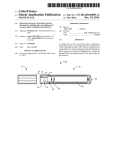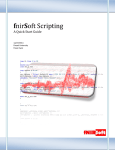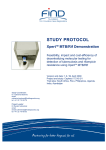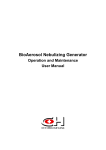Download User Manual - Alburtylab, Inc.
Transcript
AG-5025 Fluidized Bed Aerosol Generator with Vertical Elutriator OPERATION MANUAL 1 Product Overview This section contains a description of the AlburtyLab AG-5025 fluidized bed aerosol generator and a brief history of the instrument. 1.1 Product Description AlburtyLab, Inc. designs, builds, and sells the AG−5025, a custom PITT−3 type fluidized bed aerosol generator, with a remote amplifier and flow controller as shown in Figure 0. The drivers for these units are fully enclosed and the generators are built of easily-decontaminated T304 stainless steel with latex diaphragms and Teflon or butyl gaskets. Unique air-injection methods make these units exceptionally controllable. Ongoing research indicates that concentrations in the range of several mg/m3 are easily maintained for long periods of time in closed systems using this generator. Variable waveforms from almost any computer or audio signal generator can be used to drive the aerosol generator. Generators in this series range from 0.20 to 25 Lpm Figure 1. AG-5025 Aerosol Generator output, with diaphragm diameters ranging from 1.5 in to 12 in. Particle size distributions can be controlled by using well defined input materials, such as Celite(R) 545, talc, Arizona road dust, fluorescein, grain dust, dry Bacillus globigii (Bg) spores, and dry polystyrene microspheres. You can also aerosolize your own materials or reaerosolize particles captured by air sampling. Standard features include: Rugged and dependable industrial grade construction Extended-use periods enabled by fan cooled electronics Remote flow rate and amplitude controls Quick, easy, tool-free removal of entire aerosol bed, injector section, and elutriator allows swift, easy material reloading and decontamination The aerosol bed can be driven by any audio signal generator, allowing the utilization of unique wave forms or combinations of wave equations Completely sealed sample section can be used in positive or negative pressure systems AlburtyLab Inc. AG−5025 Operation Manual 1 Versatile umbilical attachments on the front and rear of the Control Unit allow for convenient placement in your lab. 1.2 Instrument History The first PITT−3 was described by Weyel et al. (1984) and was designed to generate a cotton dust aerosol. In this short communication the author provides the design details of the PITT−3 generator constructed at the University of Pittsburgh. However, none of these PITT−3 type instruments were commercially available prior to AlburtyLab’s release of the first AG−5025 model in 2007. In 2009, the AlburtyLab AG−5025 was redesigned to include a Control Unit that would allow the user to control the aerosol generator remotely. This allows for greater flexibility when employing the generator in an enclosed aerosol chamber. 2 Description The primary components of the AG−5025 Fluidized Bed Aerosol Generator with Vertical Elutriator are labeled in Figure 2. Figure 2. Primary Components of the AG−5025 AlburtyLab Inc. AG−5025 Operation Manual 2 The Elutriator Top Cap has a ¾ inch OD hose barb in the center that allows for easy connection to ¾ inch ID conductive tubing. The connection between the Elutriator Top Cap and the Elutriator Section is sealed with a gasket and a single pin heavy-duty clamp. Regulation of the flowrate through the system allows separation of lighter particles from heavier ones to be achieved in the Elutriator Section. Compressed air is introduced to the system through four nozzles located in the Four-way Elutriation Air Injection Stage. Note: The compressed air must be regulated to a pressure of 10 PSIG or less. The connection between the Four-way Elutriation Air Injection Stage and the Elutriator Section is sealed with a gasket and a single pin heavy-duty clamp. The Fluidized Bed Base Unit houses the speaker which transfers energy into the Elutriator Section through the latex diaphragm. Four wing nuts on the Four-way Elutriation Air Injection Stage hold the latex diaphragm securely in place against the stainless steel plate on top of the Fluidized Bed Base Unit. The Umbilical is composed of an air line and a ¼ inch monaural audio cable and is used to connect the Fluidized Bed Base Unit to the Control Unit. This Umbilical allows the user to control the AG−5025 remotely. The key components on the front panel and the back panel of the Control Unit are labeled in Figure 3 and Figure 4, respectively. Figure 3. Front Panel of the Control Unit AlburtyLab Inc. AG−5025 Operation Manual 3 Figure 4. Back Panel of the Control Unit An AC Power cord is provided for use with the three-prong AC input connector on the lower left side of the back panel. Power to the Control Unit is controlled by the On/Off toggle switch on the left side of the front panel. An indicator lamp above the On/Off toggle switch is illuminated whenever power to the Control Unit is switched to the On position. Connections for the compressed air input line are located on the front panel below the On/Off toggle switch and on the lower right side of the back panel. Note: Air should only be introduced through one of these connections as determined to be the most convenient for lab layout by the user. The compressed air must be regulated pressure of 10 PSIG or less to avoid bursting the internal tubing connections. Connections for the audio signal from an audio signal generator or a computer are located to the right of the air input connections on the front and the back panel. Note: Audio signal should only be introduced through one of these connections as determined to be the most convenient for lab layout by the user. Connections for the Umbilical (composed of an air line and an ¼ inch monaural audio cable) that connect the Control Unit to the Fluidized Bed Base Unit are located in the middle bottom of the front panel and on the top right of the back panel. The set of connections determined to be the most convenient for lab layout by the user should be used. The amplitude of the audio signal sent to the Fluidized Bed Base Unit is controlled by using the dial located in the middle of the front panel. Two flowmeters are located on the right side of the front panel. The Low Range Flowmeter has a range of 200 to 2500 mL/min (0.2 to 2.5 Lpm) and the High Range Flowmeter has a range of 2 to 25 Lpm. The air flowrate through the system is controlled using the knobs located at the AlburtyLab Inc. AG−5025 Operation Manual 4 bottom of each of the flowmeters. Selection of the desired flowrate range is made using the High/Low toggle switch located to the left of the Low Range Flowmeter on the front of the Control Unit. Air flow and audio signal to the Fluidized Bed Base Unit can be turned on and off at the Control Unit by switching the Run/Standby toggle switch located to the right of the On/Off toggle switch on the front of the Control Unit. An indicator lamp above the Run/Standby toggle switch is illuminated whenever it is switched to the Run position. The key components on the Fluidized Bed Base Unit are labeled in Figure 5. Connections for the Umbilical (composed of an air line and a ¼ inch monaural audio cable) that connect the Fluidized Bed Base Unit to the Control Unit are the only connections on the Fluidized Bed Base Unit. The four wing nuts secure the Four-way Elutriation Air Injection Stage to the Fluidized Bed Base Unit. It also is used to hold the latex diaphragm in place. The latex diaphragm is installed by loosening these wing nuts and placing the diaphragm under the bottom gasket. While tightening the wing nuts the diaphragm is gently pulled on each side. The diaphragm should be taut but not overly stretched. Air is introduced to the Elutriation Section through four air nozzles in the Elutriation Air Injection Stage. These nozzles can be adjusted as desired. An individual or a combination of nozzles can be used by installing a hose clamp on the air lines leading to the unwanted nozzles. Figure 5. Fluidized Bed Base Unit with Four-Way Air Injection Stage AlburtyLab Inc. AG−5025 Operation Manual 5 3 Safety Flammable or volatile substances should never be aerosolized using the AG−5025. For all other substances, refer to their Material Safety Data Sheet (MSDS) for proper handling and safety precautions. There are no inherent safety risks in operating the AG−5025 when used as directed. However, if operating in close quarters for prolonged periods of time, hearing protection should be used. 4 Unpacking and System Setup This section provides information concerning the accessories shipped with the AG−5025 Fluidized Bed Aerosol Generator and describes basic setup procedures. 4.1 Packing List Table 1 provides a packing list of all items that should have been shipped to you. Please compare the list to the items you received. If any items are missing, notify AlburtyLab immediately. Table 1. Accessories Packing List Qty 1 1 1 1 1 2 3 1 1 1 1 2 Description Control Unit Fluidized Bed Base Unit Four-way Elutriation Air Injection Stage Elutriator Section Elutriator Top Cap Single Pin Heavy-Duty Clamp Gasket AC Power Cord Compressed Air Input with HEPA Filter ¼ inch to ⅛ inch Monaural Audio Cable Umbilical (Air Line and ¼ inch Monaural Audio Cable) Latex Diaphragm Part No. AG-2006 AG-2007 AG-2008 AG-716-2 AG-716-1 AG-HHM-OH AG-40-E5 AG-2013 AG-2003 AG-25-125 AG-2016 AG-LR-4.75 4.2 Requirements The following is required for use of the AG−5025 Fluidized Bed Aerosol Generator: Compressed air source that can be regulated to 10 PSI and capable of supplying greater that 30 Lpm 120VAC grounded power supply ¾ inch ID conductive silicone tubing Audio signal generator or a computer with an audio output 4.3 Setup The system is setup for use as follows: Switch the On/Off toggle switch on the front of the Control Unit to the Off position. AlburtyLab Inc. AG−5025 Operation Manual 6 Switch the Standby/Run toggle switch on the front of the Control Unit to the Standby position. Set the regulator on the compressed air source to 10 PSI. Connect a regulated air supply line to the compressed air input with HEPA filter that was shipped with the system. Connect the air input with HEPA filter line to one of the Air In connections on the Control Unit (front or rear, as desired for lab layout). Connect the AC power cord to the 110-120VAC connection on the back of the Control Unit and then into an available power outlet. Switch the On/Off toggle switch on the front of the Control Unit to the On position to verify the unit has power. Connect the ⅛ inch audio jack end of the Monaural Audio Cable to an audio signal generator or a computer and the ¼ inch audio jack to one of the Signal In connections (front or rear, as desired for lab layout). Connect the air line portion of the umbilical to one of the Air Out connections on the Control Unit (front or rear, as desired for lab layout) and connect the other end to the Air In connection on the Fluidized Bed Base Unit. Connect the audio cable portion of the umbilical to one of the Signal Out connections on the Control Unit (front or rear, as desired for lab layout) and connect the other end to the Signal In connection on the Fluidized Bed Base Unit. Install the latex diaphragm by loosening the wing nuts on the Four-way Elutriation Air Injection Stage and placing the diaphragm under the bottom gasket. While tightening the wing nuts gently pull the diaphragm on each side. The diaphragm should be taut but not stretched. Adjust the four-way elutriation air injection nozzles shown in Figure 4 as desired for dissemination. Figure 4 4.4 Sample Loading The test dust is loaded into the system as follows: Pour the sample onto the center of the diaphragm as shown in Figure 5. Place a gasket on top of the Four-way Elutriation Air Injection Stage. Place the Elutriator Section on top of the gasket and tighten the single pin heavy-duty clamp as shown in Figure 6 and Figure 7. Place a gasket on top of the Elutriator Section. Place the Elutriator Top Cap on top of the gasket and tighten the single pin heavy-duty clamp. AlburtyLab Inc. AG−5025 Operation Manual Figure 5. 7 Figure 6. Figure 7. Connect the conductive tubing to the ¾ inch OD hose barb on the Elutriator Top Cap with as few bends and as short a length as possible, connect the other end of the conductive tubing to the aerosol chamber or flow tube, etc. 5 Operation 5.1 Signal Settings Guidance The AlburtyLab AG−5025 has a frequency response of 30-3000 Hz. The particular frequency to use depends on what is being aerosolized, so some experimentation may be needed to find the “sweet spot” for your application. 440 Hz is generally a good starting point. Some dust samples have a tendency to form harmonic patterns on the diaphragm and get stuck. If this occurs, try using a frequency sweep of 100 Hz or more per second. For example; if harmonic patterns are forming at 330 Hz, try a logarithmic bidirectional sweep between 280 and 380 Hz over a period of 0.7 seconds. A sine waveform is recommended for most applications. Square wave and saw tooth waveforms can also be used; however, they should only be used at low amplitudes due to the increased strain on the amplifier. 5.2 Aerosol Generation The system is prepared for dry powder dissemination as follows: Turn the Amplitude control dial on the front of the Control Unit all the way down (CCW). Switch the On/Off toggle switch on the front of the Control Unit to the On position. AlburtyLab Inc. AG−5025 Operation Manual 8 Switch the Standby/Run toggle switch on the front of the Control Unit to the Run position. Note: Never switch Control Unit from Standby to Run unless the Fluidized Bed Base Unit is connected by the umbilical. Damage to the amplifier may result. Turn on the audio signal generator or start the signal generator software on your computer. One possible audio signal generator that can be used is SigJenny. SigJenny is a freeware signal generator program written by NaTCH engineering and is available for download at their website: http://www.natch.co.uk/. SigJenny is simple to use. Set the desired frequency in the “Frequency 1” box and uncheck the mute box under the left corner of the graph. For a frequency sweep; check the “Sweep” box and set the “Frequency 1” and “Frequency 2” to the desired values. Some users have experienced difficulty using SigJenny with Windows Vista. If you experience any problems, contact AlburtyLab for suggested solutions. Start the signal generator at approximately 50% volume. Slowly increase the input level by turning the Amplitude control dial on the Control Unit clockwise to the desired level. Once the input level is set, it can be turned on and off at the Control Unit by toggling the Run/Standby toggle switch, at the signal generator, or by muting/unmuting the computer output. Switch the High/Low toggle switch on the front of the Control Unit to the desired flow rate range. The Higher flow rates will allow more particles to escape the elutriator; however, higher flow rates will also allow larger particles to escape. Set the desired flow rate on the applicable flowmeter (high or low range) on the front of the Control Unit. The chart contained in Figure 6 can be used as a starting point for aerosolizing particles with a known size distribution. The data in this graph was generated for dissemination of particles of two different densities and using the AG−5025. AlburtyLab Inc. AG−5025 Operation Manual 9 Aerodynamic Particle Diameter (um) 70 Density = 2.7 g/cm3 60 Density = 1.2 g/cm3 50 40 30 20 10 0 0 5 10 15 Flowrate (Lpm) 20 25 30 Figure 6. Flowrate Associated with Particle Settling Velocity 6 Cleaning and Maintenance The Elutriator Section, Four-way Elutriation Air Injection Stage, and Elutriator Top Cap are made of T-304 stainless steel and can be cleaned with most standard cleaners such as bleach, alcohol, or hydrogen peroxide. The latex diaphragm can be disinfected using 10% bleach, 3% Hydrogen peroxide, or by autoclaving. The only user-serviceable maintenance item on the Control Unit is the air filter located on the back. It should be removed and cleaned with water every 24 hours of operation depending on conditions. The HEPA filter in the Compressed Air Inlet Line purifies the injection air. This should not have to be changed unless water is allowed to enter the air line or a drop in the maximum flow rate is observed. Replacement filters can be obtained from AlburtyLab. 7 Specifications 120VAC, 30W Frequency response range: 30-3000 Hz Flow rate range: 0.20-25 Lpm Maximum compressed air input: 10 PSIG 0.02 µm internal air filter Diaphragm diameter: 4.75 inches 8 Bibliography Weyel, D.A., M. Ellakkani, Y. Alarie, and M. Karol. 1984. An aerosol generator for the resuspension of cotton dust. Toxicol. Appl. Pharmacol. 76:544-547. AlburtyLab Inc. AG−5025 Operation Manual 10 AlburtyLab Inc. AG−5025 Part List Description Complete AG−5025 (4.75 in diaphragm) Replacement Diaphragm 0.006 Latex (4.75 in) 0.02 µm Injection Air Filter Conductive Silicone Tubing (3/4 in dia.) Signal/compressed air umbilical line AlburtyLab Part No. AG-5025 AG-LR-4.75 AG-2003 AG-2004 AG-2016 Price $9995.00 $24.95 $129.95 $44.95/foot $99.95 Contact AlburtyLab for a consultation and estimate on custom vertical elutriator sections. Not equipped to perform specialized aerosol tests? Let us do them for you! AlburtyLab is a focused aerosol laboratory providing a full range of research, development, and third party validation services. We also design and build custom wind tunnels, flow systems for testing aerosol detection and collection systems, aerosol inlets and aerosol generators. AlburtyLab also offers computational fluid dynamics (CFD) analysis, third party testing validation, and all types of aerosol testing. Located in Drexel, Missouri, just south of Kansas City, AlburtyLab serves the aerosol research, development and instrumentation communities. Our associates and specialized facilities combine to help our customers develop and improve their products. AlburtyLab is your source for everything aerosol! Dave Alburty Aerosol Scientist and President [email protected] Zach Packingham Design Engineer [email protected] AlburtyLab.com 128 E. Main St. Drexel, MO 64742 816.619.3374 AlburtyLab Inc. AG−5025 Operation Manual 11











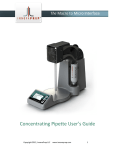
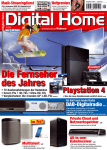
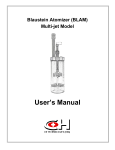
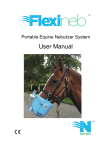
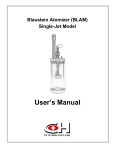


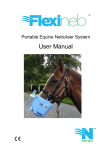


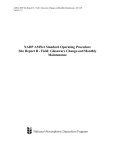

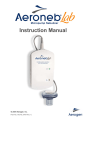

![*Sted Plus UG Jan 2012 [2].indd](http://vs1.manualzilla.com/store/data/005710511_1-f757ed41a0935df19f469c7cee361c5b-150x150.png)
